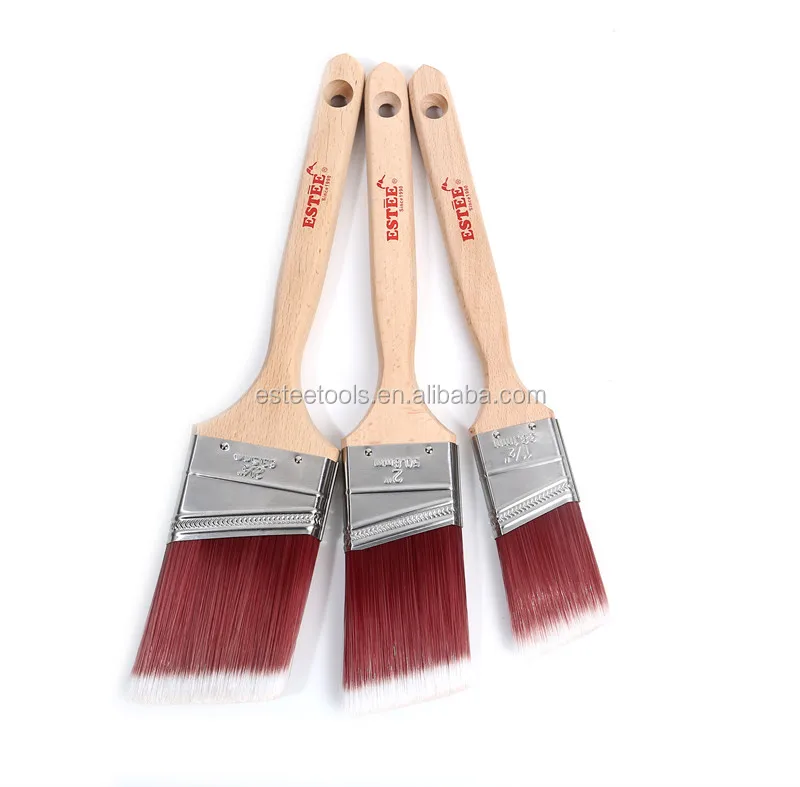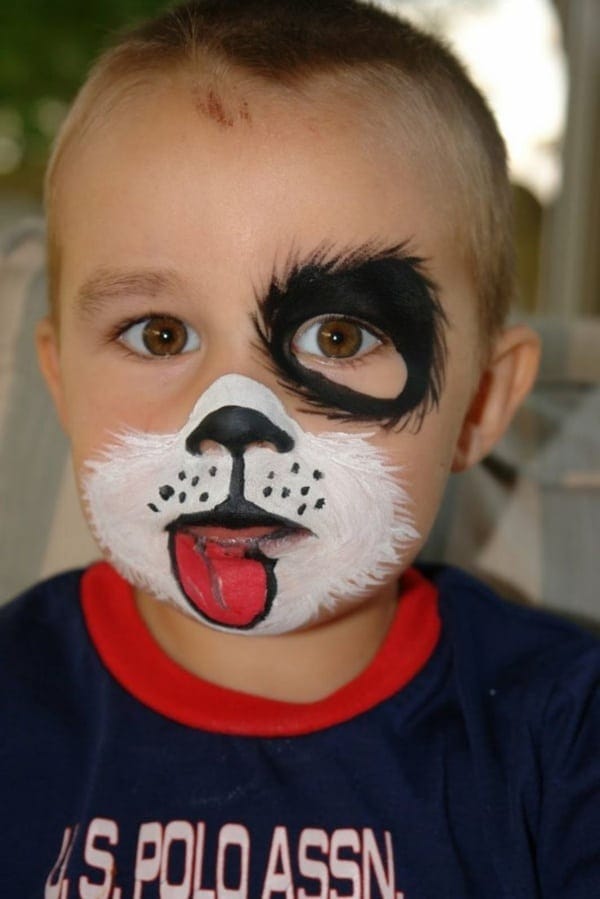Media Gallery
High quality paint brushes made with a straight black synthetic polyester, red-painted wooden “beaver-tail” handle and metal ferrule. Ideal for multi-use jobs; for a smooth finish on a variety of surfaces. Perfect for use with water-based paints.
Choosing the right paint brush for your task will make the job easier and provide superior results. These paint applicators come in a variety of shapes, sizes and different filament materials.
- Purdy XL Glide Nylon- Polyester Blend Angle 3-in Paint Brush. The Purdy XL brushes feature the iconic copper ferrule and work great for all projects - interior and exterior and with all paints and stains. They're Purdy's most versatile brush!
- These high-performance, synthetic and squirrel-and-synthetic brushes have many of the qualities of ones made from natural hair. Designed specifically for water-based mediums, the 14 brushes in this.
- If you’re applying oil-based varnish or paint, a natural-bristle (Black China, Ox-hair Blend or White China) brush may be a better choice. You can use synthetic-bristle brushes for oil-based paint, but in most cases, natural bristles will provide a smoother finish. Avoid using a natural bristle brush to apply water-based finishes, though.
As a professional house painter, I own two dozen or more brushes, each with its own use. Typically each project you do will require two brushes, one for large areas or general use and one for the finer details.
The best sizes are 3 inch for general cutting in or large pieces of trim and 1-1/2 for the finer details.
A professional paint brush applies a smoother finish with less brush strokes; paint is applied faster and with less effort. Plus, if properly cleaned and stored will last for years. Inexpensive paint brushes can shed bristles into the finish and are difficult to work with, producing an inferior finish and more frustration.
A straight line is what you want! It is well worth the extra cost for a good brush or two. Matching the right application tool to your job begins with the actual type of primer, paint or clear finish you are using. Paint brushes are categorized according to the type of coating being applied.
- Water Based Paints and Primers – Typical latex or acrylic paints and primer plus water based epoxy.
- Oil Based Paints and Primers – Alkyd paints and primers plus oil based epoxies. All solvent thinned paints and primers.
- Water Based Clear Wood Finishes and Stains – Includes acrylic urethane, water based polyurethane and its variants plus water based wood stains.
- Oil Based Clear Wood Finishes and Stains – This includes the common varnish and polyurethane plus oil based wood stains. All solvent thinned clear finishes and wood stains.
- Shellac Primers and Clear Finishes – Tinted and clear shellac is thinned with denatured alcohol. Some stain blocking primers are tinted shellac.
Each of these “types” of coatings or stains has a specific type of brush that is used. Type of paint brush refers to the filaments used in its construction. These filaments can be synthetic, natural, or a combination of the two.
- Synthetic refers to different types of plastics used to make the filaments, nylon and polyester or blends of the two. Other types of plastics have been invented, such as Chinex, and can be combined with nylon or polyester to produce different characteristics.
- Natural refers to animal hair that is used in the brushes construction, this type of filaments are called bristles. The most common type of hair used is imported from China and taken from long haired hogs. Another type is Ox hair.
The key point is that most filaments are designed for specific solvents and will be damaged if used in the wrong solvent.
Choosing a Paint Brush for Water Based “Water Thinned” Products
Synthetic brushes such as Polyester, Nylon and Poly/nylon blends are used to apply water based primers and finishes. These brushes can be used with all paints, but are best suited for Acrylic or Latex. They offer good stiffness verses softness for today’s thick paints.

Polyester brushes hold and release more paint, providing smoother finishes plus clean-up is faster and more thorough than other synthetics. Nylon brushes wear longer and are stiffer than any other filament. A nylon brush is well suited for rough surfaces.
Poly-Nylon blends provide longer wear, maximum resiliency and easy clean up. These are the most common type of brush on the market.
- Latex and Acrylic Primer and Paint – Thick paints demand a stiff brush. Although this works for most interior or exterior painting, when it’s time to prime and paint doors and other surfaces needing a smooth surface choose a softer brush. The poly-nylon blended paint brushes are available in different levels of softness and stiffness. Choose a stiff brush for painting exterior trim or cutting in interior walls. For interior trim and brushing smooth doors using acrylic enamel a softer brush is needed.
- Water Base Clear Wood Finishes and Stains – Includes acrylic urethane and water borne polyurethane, require synthetic filament brushes. Polyester provides a fine finish and easy application. Special synthetic blends, such as Chinex, are the best choice for these finishes. Choose a brush that is very soft, stiffness isn’t an issue as these finishes are very thin out of the can.

Choosing a Paint Brush for Oil Base “Solvent Thinned” Products
High Quality Synthetic Bristle Paint Brush
Oil base or Alkyd primers and finishes require natural filament blends for the best results. Although some synthetic brushes say “For All Paints”, they can’t beat natural animal hair.
Synthetic brushes loose there shape in oil base paints and primers, an oil paint brush must be stiff enough to hold its shape and soft enough not to leave to many brush marks.
Brush manufactures use a blend of different natural bristles to change the softness and stiffness. These blends are Black China bristle, White China bristle and Ox hair brushes. All of these natural bristle types can be combined with each other or with synthetic filaments.

- Black China Bristle Paint Brushes – Black China bristle brushes are perfect for use with oil base paint, primer and enamels. This type of natural bristle brush has the stiffness for cutting in a straight line and thicker hair for holding more paint.
- White China Bristle Paint Brushes – White China bristle brushes is a great choice for varnishes, polyurethane and stains. White bristles are finer than Black China bristles and provide a finer finish. Watch out for cheap white bristle brushes. They fall apart very easily.
- Ox Hair Blends – Clear wood finishes require a very soft brush for the best results and Ox hair blends are the softest, the perfect varnish brush. Usually a blend of Ox hair with white bristles, black bristles or synthetic filaments for stiffness.
These brushes cannot be used with latex paints or be cleaned with water this will ruin the brush! Never use a natural bristle brush in water or water based products. Natural bristle paint brushes absorb water and loose their shape, becoming imposable to control.
The Best Paint Brush for Shellac “Alcohol Thinned” Products
Shellac, clear as well as tinted, is a thin product and can be difficult to apply with a brush. You will need a brush that can absorb a lot of material and release it easily. A high quality white china bristle is the best brush for shellacs. Natural filaments are not damaged by alcohol.
Tinted shellac primer is a thicker product than clear finishing shellac, but still thinner than paint. Use a white china bristle brush when using tinted shellac.
Shapes and Sizes of Paint Brushes
Paint brushes come in a variety of shapes such as Angular, Flat, and Oval, and size ranges from 1—6 inches wide.
Angular brushes are great for surfaces that have many angles, narrow surfaces or are hard to reach, an excellent choice for an all-purpose brush. Flat and oval brushes can be used on all surfaces but are best suited for flat surfaces such as wide trim, doors and cutting-in walls or ceilings.
Determining which paint brush is best for your project is based on type of paint or finish, surface to be painted and which one your most comfortable using. I use a variety of different brushes ranging from 1 inch to 4 inches. Typical size is 2-1/2 inches for basic cut-in and 1-1/2 inches for small trim. Try to use the largest brush for the surface to be painted.

Paint Brush Descriptions and Use
- 1—2 Inch is a good choice for small surfaces such as touch-up, trim, moldings and window sashes.
- 2—3 Inch work great for general cutting in of walls as well as exterior trim.
- 4—6 Inch brushes are for large areas such as back brushing behind an airless sprayer or applying stain to a deck floor.
Best Synthetic Paint Brush
